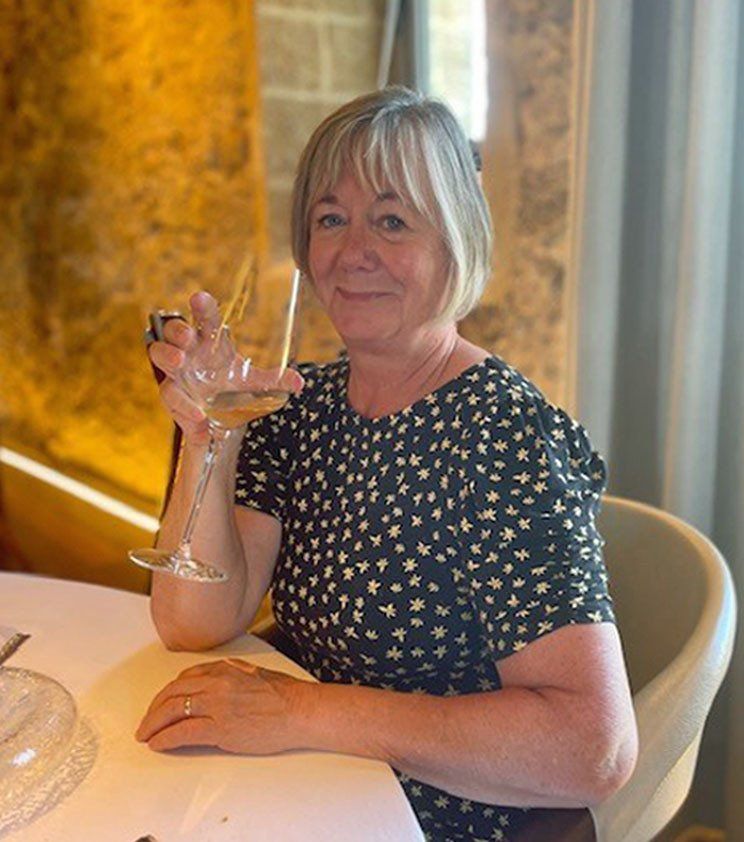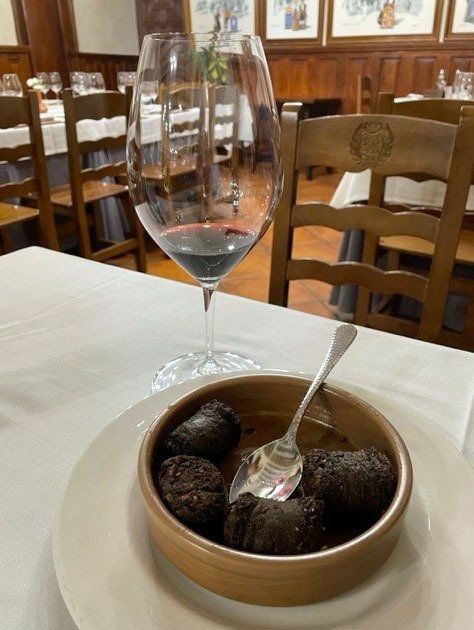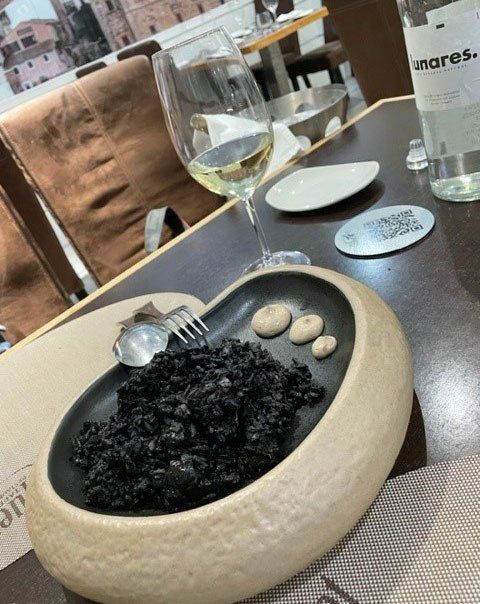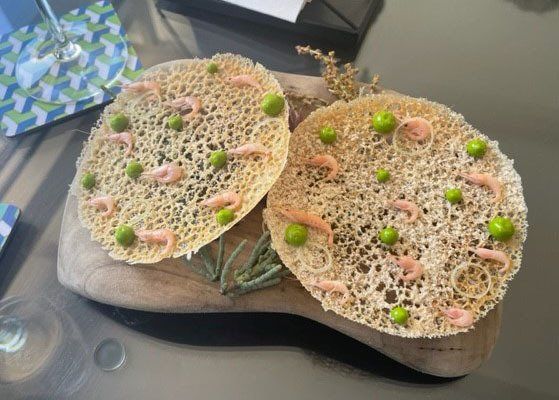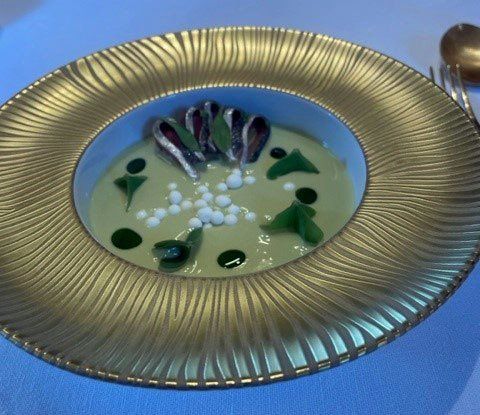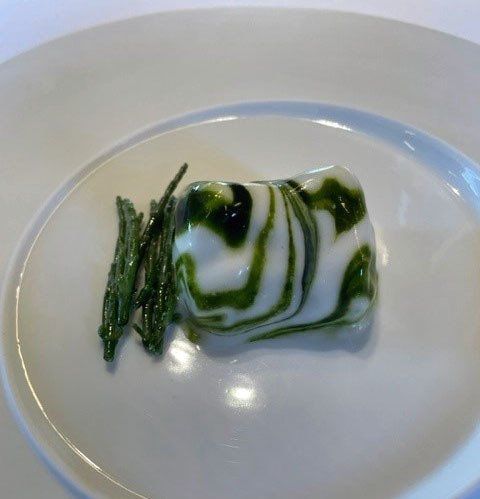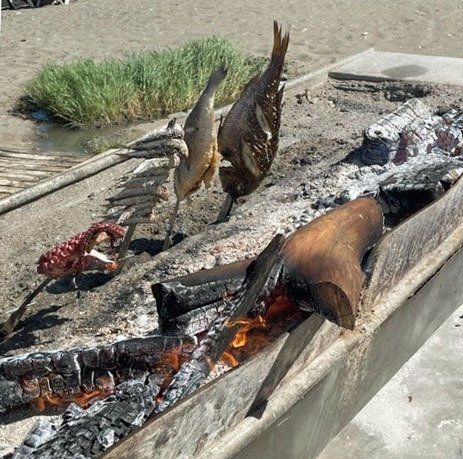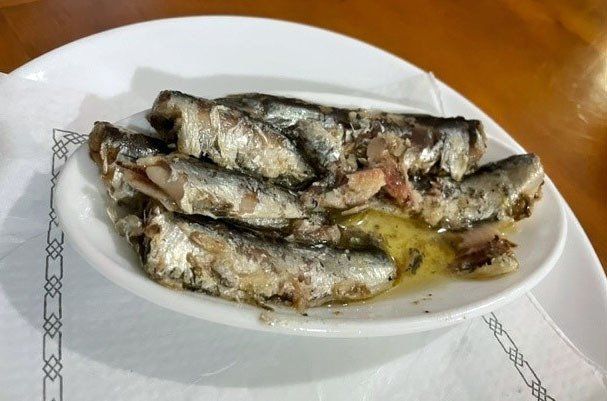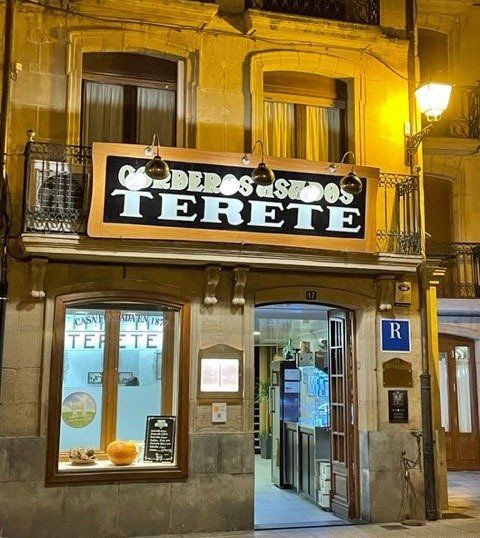Not just paella and sangria:
A gastronomic trip to Spain
Vinny Logan and Geoff Hodgson
We’ve all eaten paella and drunk sangria.
But is there much more to Spanish food and wine?
In September and October 2022, we toured Spain. For years we had wanted to discover more about Spanish cuisine. We’d visited Spain many times, but apart from Catalonia and Asturias, we had limited acquaintance with other regional food. Although our knowledge of French wine is pretty good, neither of us had much of a clue about good Spanish wine.
• Segovia
• Cáceres
• Cádiz
• Estepona
• Cordoba
• Rioja wine area
• San Sebastián
We saw some amazing sights and had a good time meeting up with some friends who have a second home in Spain. But the focus of this blog is the food and drink that we discovered along the way.
Our first stop in Segovia was one of the big discoveries of the trip. We knew that Segovia is famous for suckling pig (cochinillo). We tried it at a local tapas bar called Mesón de José Maria. The cochinillo
was indeed delicious, but the real discovery was the local variety of morcilla
– a type of Spanish black pudding. Geoff has always been a fan of black pudding, but Vinny never liked it very much. But we agreed that this local variety tasted amazingly good. It is lightly spiced and slightly crumbly in texture. It is a bit like haggis – delicious and not at all fatty. It was fried before serving – so crispy and dry, if somewhat calorific.
We stopped in the pretty town of Cáceres overnight, where we enjoyed some lovely fish and seafood dishes at Taperia Restaurant Bouquet, including tuna sushi, and some lovely black squid ink rice. We ordered raciones, a tapas which is large enough to share.
In Cáceres we made our first major wine discovery of the trip. The knowledgeable waiter recommended Habla de Ti. It is local organic white wine from Extramadura, made solely from sauvignon blanc grapes, voted the best white wine in Spain in 2015. Fresh and intense but dry, we loved it. The design on the bottle isn’t terribly inspiring, but don’t let that put you off. It’s possible to order Haba de Ti from several online wine outlets in the UK.
Our next stop was Cádiz. We wanted to visit Apoinente, a three-star Michelin restaurant based in nearby El Puerto de Santa Maria. Cádiz is also a really attractive city, with stunning seascapes, fascinating history and a great Parador hotel. Visiting Michelin three-star restaurants is not something we do every day, but this place was simply stunning.
We took this gastronomic trip to celebrate the fact that we can both travel again, after a tough year when Geoff needed surgery, chemotherapy and radiotherapy. And what a place to celebrate! The restaurant is beautiful, and the excellent service was pure theatre. But the food is the star of the show. Dozens of small plates were beautifully showcased using marine ingredients: sea snails, sea urchins, kelp, seaweed and sea vegetables. Vinny is not an adventurous eater of unusual sea products, but for both of us, every bite was utterly gorgeous. Everything we ate was stunning. Memorable courses include the tapas of ‘ham’ and ‘cheese’ – all made out of sea produce.
We took this gastronomic trip to celebrate the fact that we can both travel again, after a tough year when Geoff needed surgery, chemotherapy and radiotherapy. And what a place to celebrate! The restaurant is beautiful, and the excellent service was pure theatre. But the food is the star of the show. Dozens of small plates were beautifully showcased using marine ingredients: sea snails, sea urchins, kelp, seaweed and sea vegetables. Vinny is not an adventurous eater of unusual sea products, but for both of us, every bite was utterly gorgeous. Everything we ate was stunning. Memorable courses include the tapas of ‘ham’ and ‘cheese’ – all made out of sea produce.
Another mind-blowing course was a ‘tarte tatin’, made from apples on a base of seaweed. Sorry, no pic as we were too focused on devouring it! Finally we were introduced to Jerez (sherry) served as a dessert wine. We’ve always thought of sherry as something ordinary that your grandma might tipple on Sundays. We learned rather late that this is simply not the case. We discovered other sherries during our trip and one in particular made its way into our post-Brexit booze allowance, ready for Christmas Day.
Aponiente
is expensive, so be prepared. Its philosophy is that we should utilise the rich source of food in the sea much more than we do currently. This does raise some questions about cost and environmental impact. But it made us think about making more use of resources from the sea. Our visit to Aponiente
will stay with us.
On to less expensive food options! A tapas we really enjoyed in Cádiz and other places was tortillitas de camarones. We first heard about these on a Rick Stein TV episode, where he raves about them. They are small fritters made of chickpea flour, wheat flour, onion, shrimp and parsley. They are the perfect accompaniment to a glass of cold white wine or sherry.
Our friends in Estepona introduced us to the chiringuitos. These are bars with food and drink, sometimes little more than a shack, found on the beaches of Andalucia. Chiringuito Torre Velerin was typical, with a large makeshift BBQ area, cooking fresh fish and seafood – relaxed, informal and great value.
On a day out in the mountains behind Estepona, we explored the beautiful high-perched town of Ronda. The old Arab baths, the amazing bridge across the deep gorge, and the stunning bull ring and its museum, are all good reasons to visit. We were lucky enough to discover the best tapas bar on our whole Spanish trip as well. A few days before an English couple had told us about Casa Mateos
in Ronda. We arrived slightly early for lunch – around 1.30pm! – they were just opening up. The tapas were tasty, of great quality, with some amazingly innovative food combinations: heuvos trufados
(potato, ham, omelette, and truffle) and champinones salteados
(langoustines and mushrooms).
In Cordoba we tried the dish for which the city is famous. Flamenquin
are slices of serrano ham wrapped in pork loin and coated in breadcrumbs, but we weren’t that impressed. Not as good as the best Wiener Schnitzel.
Wines from Montilla-Moriles are classified in the same way as sherry: Fino, Amontillado, Oloroso and Pedro Ximénez, but technically they are not sherry. The grapes grown in Montilla-Moriles are ideal for making Pedro Ximénez, as it is inland and has a lower humidity. The Denominación de origen Jerez
has a rule whereby Pedro Ximénez can legally be called ‘sherry’ if it has spent at least two years in a bodega in Jerez. All very complicated. But the take-home message is, forget your grandma’s sherry, and just try these Spanish varieties.
The fino version from Montilla-Moriles was also very good when tasted at the Bodega Guzman
in Cordoba. We had four sizeable tapas and two glasses of wine that cost 13 euros, making up for the financial blow-out at Aponiente mentioned earlier!
Another highlight of this gastronomic trip was our visit to the Rioja wine region. We’ve drank our fair share of Rioja over the years, but to be honest, we’ve never really taken the time to understand the wine properly. This was our chance.
We based ourselves in the small town of Haro. It works its charm as you get to know the place. It has over 20 wineries, many of which are clustered in the old railway area of town – Estacion de Haro. This area has an interesting history. From the 1850s, wine transportation switched from horse drawn carriages to the railway, which provided a connection to France. In the 1860s and 1870s many French vineyards were devastated by phylloxera, a microscopic aphid that caused the Great French Wine Blight. Vintners from Bordeaux and elsewhere moved to Haro and joined up with local vineyard owners.
• CVNE
• R. Lopez De Heredia
• Gomez Cruzado
• La Rioja Alta
• Muga (established in 1932)
Wine-tasting in these wineries is a bit different from degustation
in French vineyards. Some of them in Rioja require you to contact them prior to your visit, and they often ask that you pay per glass tasted. We found that the wineries listed above did not require a reservation, except R. Lopez De Heredia. The wineries themselves are welcoming, classy, informative and well organised. If you buy a number of bottles, they often drop the charges for the tastings. Red Rioja wines are generally based on the tempranillo grape. There are the three main categories:
• Reserva red wines must be aged in oak barrels or bottles for be a minimum of three years, with a minimum of one year in oak barrels.
• Gran Reserva red wines
must spend at least two years in oak barrels, followed by at least three years in bottles. Many new release Gran Reservas are around ten years old or more.
The same terms are used for Rioja white wines, but the rules are slightly different. We paid between 15-25 euros per bottle for a selection of all the above types, and we have kept a couple of bottles of Gran Reserva for Christmas Day.
Our last stop on this enlightening and highly enjoyable food and wine tour was San Sebastian. It is a beautiful coastal city in the Basque region, famous for its pinxtos bars
and food. But we found the old town extremely crowded and didn’t feel comfortable. But we managed to find a couple of excellent small restaurants close to our hotel, near to Ondaretta Beach. We had our last fishy meal in Spain at Abakando, which we recommend.
On our final day we found the most perfect txuleta steak at Tximis Tarri steakhouse. Their huge rib steaks come from older cattle, aged between eight and eighteen years. The meat, almost a maroon colour and edged with distinctive yellow fat, is renowned for its depth of flavour and marbling. It’s usually cooked a la plancha and is so big that sharing is essential. It was served with simple grilled red peppers, and oven roasted potatoes, a fabulous end to our food and wine tour of Spain.
Buen provecho!
Published 20 November 2022

